人教版七年级英语下册第四单元教案
- 格式:doc
- 大小:30.50 KB
- 文档页数:7
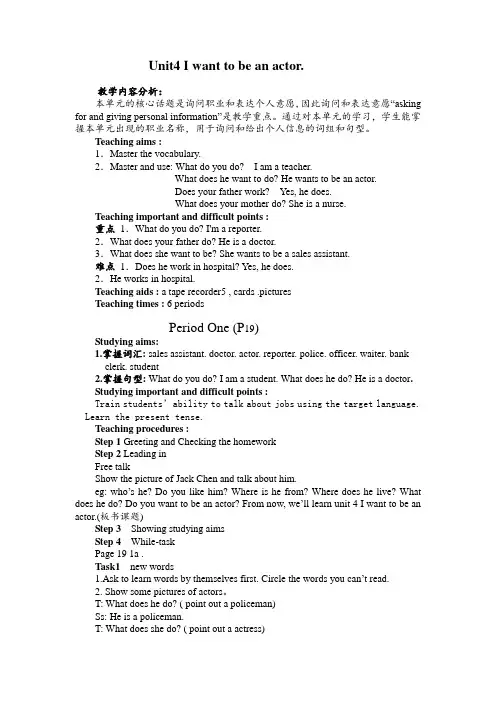
Unit4 I want to be an actor.教学内容分析:本单元的核心话题是询问职业和表达个人意愿,因此询问和表达意愿“asking for and giving personal information”是教学重点。
通过对本单元的学习,学生能掌握本单元出现的职业名称,用于询问和给出个人信息的词组和句型。
Teaching aims :1.Master the vocabulary.2.Master and use: What do you do? I am a teacher.What does he want to do? He wants to be an actor.Does your father work? Yes, he does.What does your mother do? She is a nurse.Teaching important and difficult points :重点1.What do you do? I'm a reporter.2.What does your father do? He is a doctor.3.What does she want to be? She wants to be a sales assistant.难点1.Does he work in hospital? Yes, he does.2.He works in hospital.Teaching aids : a tape recorder5 , cards .picturesTeaching times : 6 periodsPeriod One (P19)Studying aims:1.掌握词汇: sales assistant. doctor. actor. reporter. police. officer. waiter. bankclerk. student2.掌握句型: What do you do? I am a student. What does he do? He is a doctor.Studying important and difficult points :Train students’ability to talk about job s using the target language. Learn the present tense.Teaching procedures :Step 1 Greeting and Checking the homeworkStep 2 Leading inFree talkShow the picture of Jack Chen and talk about him.eg: who’s he? Do you like him? Where is he from? Where does he live? What does he do? Do you want to be an actor? From now, we’ll learn unit 4 I want to be an actor.(板书课题)Step 3Showing studying aimsStep 4While-taskPage 19 1a .Task1 new words1.Ask to learn words by themselves first. Circle the words you can’t read.2. Show some pictures of actors。
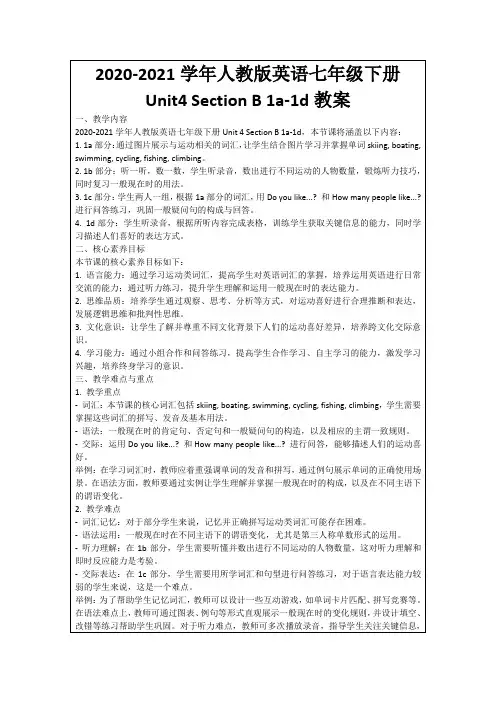
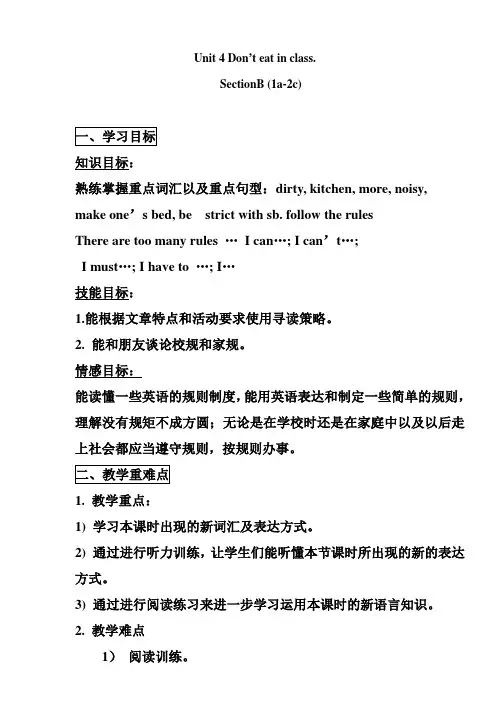
Unit 4 Don’t eat in class.SectionB (1a-2c)知识目标:熟练掌握重点词汇以及重点句型:dirty, kitchen, more, noisy,make one’s bed, be strict with sb. follow the rulesThere are too many rules …I can…; I can’t…;I must…; I have to …; I…技能目标:1.能根据文章特点和活动要求使用寻读策略。
2. 能和朋友谈论校规和家规。
情感目标:能读懂一些英语的规则制度,能用英语表达和制定一些简单的规则,理解没有规矩不成方圆;无论是在学校时还是在家庭中以及以后走上社会都应当遵守规则,按规则办事。
1. 教学重点:1) 学习本课时出现的新词汇及表达方式。
2) 通过进行听力训练,让学生们能听懂本节课时所出现的新的表达方式。
3) 通过进行阅读练习来进一步学习运用本课时的新语言知识。
2. 教学难点1)阅读训练。
2)理解must, have to/ can/can't的用法三、学习过程Ⅰ. Warming- up and revision1. Greet the Ss.2. Check the homework. Let some Ss read their home rules.3.通过图片提问Do you know these signs in a city?What do they mean?4.再通过运用思维导图进行引导How many rules do you know?Ⅱ. Presentation1. Show some pictures on the big screen and let Ss learn the new words and expressions.2. 学生看着1a部分的图片___ go out___ see friends___ do his homework___ practice the guitar___ do the dishes___ watch TV___ help his mom make breakfast___ clean his room进行FREE TALKWhat can you do at home ?What can’t you do ?Can you go out on school nights?Ss: No, we can’t.T: Yes, in China, the students can’t go out on school nights.So please don’t go out on school nights.Ⅲ. Listening1. Tell Ss they'll listen to the recording about Dave's house rules. Listen and put an× for things Dave can't do and a √for things he has to do.2. Play the recording for the Ss to listen and check.3. Play the recording again for the Ss to check the answers.Ⅳ. Listening1. Now let's work on 1c. Now first, let's read the phrases aloud together.help his mom makebreakfastclean his roomWhat are the rules at your home?Can you go out on school nights?Do you have to do your homework first?Lead-inWhen you are unhappy about something, who do you like to talk to ?Task 1.Skimming (速读--默读)1. What’s Molly’s problem?2. Does she have rules in school?3. What does Molly think of the rules?Read 2b quickly and find the main idea. The main idea of the two letters is that___. A: there are many rules for MollyB: Dr. Know wants to help MollyC: Molly asks Dr. Know for some help and Dr. Know gives her some help.Task2. ScanningRead the letters again and complete the timeline (再读信,并且完成时间轴. )Task3.Detailed readingA).Read the first paragraph and fill in the blanks.B)Read the second paragraph and fill the rule made by her dad.C) Dr. Know's advice: We have to _____________.观察与思考求助信的写作格式:1)2)3)2c Read the letters again. Complete the sentences with have to/must, can or can’t.1. Molly _____ play basketball on school days, but she ____ play it on weekends.2. Molly _____ do her homework first when she gets home.3. Molly _____ read a book after dinner before she _____ watch TV.4. At school, Molly ____ be noisy or eat in class.5. Parents and schools make rules to help students. So students ______ follow the rules.Group worke.g.:At school/home/the library, we have to(must) ...We can't...(巩固)Language points1. _________ the guitar 练习吉他practice v.意为“练习”后面可跟名词、代词或动名词。
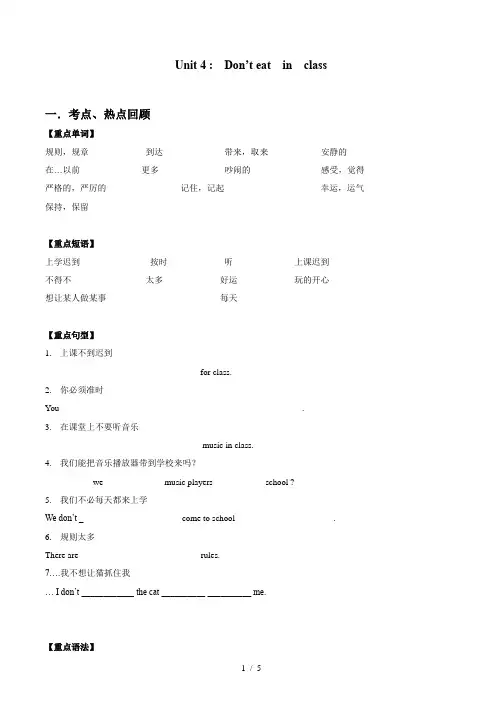
Unit 4 : Don’t eat in class一.考点、热点回顾【重点单词】规则,规章__________ 到达____________ 带来,取来__________ 安静的_______________ 在…以前______________更多______________ 吵闹的______________ 感受,觉得___________ 严格的,严厉的______________ 记住,记起__________________ 幸运,运气___________ 保持,保留__________________【重点短语】上学迟到_____________ 按时__________ 听____________ 上课迟到_____________不得不______________ 太多____________ 好运_____________玩的开心_____________想让某人做某事__________________ 每天______________【重点句型】1.上课不到迟到__________ ___________ __________ for class.2.你必须准时You _____________ ____________ ____________ ____________.3.在课堂上不要听音乐__________ _________ __________ music in class.4.我们能把音乐播放器带到学校来吗?_________ we __________ music players ___________ school ?5.我们不必每天都来上学We don’t ___________ __________ come to school __________ __________.6.规则太多There are ___________ ______________ rules.7….我不想让猫抓住我… I don’t ____________ the cat __________ __________ me.【重点语法】【祈使句】祈使句是用来表示命令,请求或建议的一种句型。
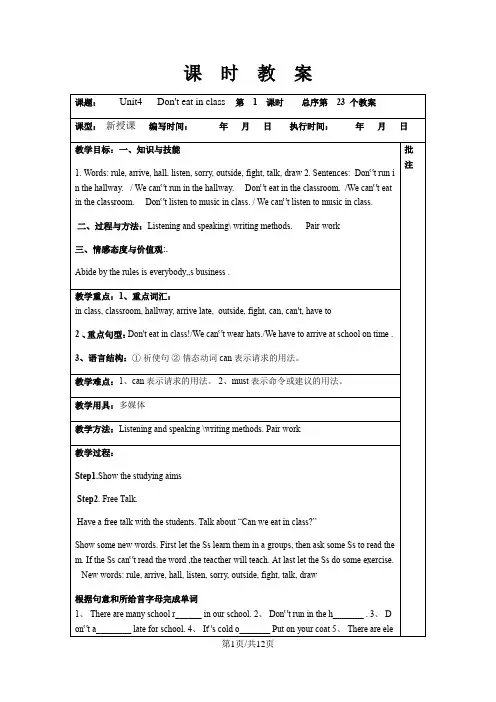
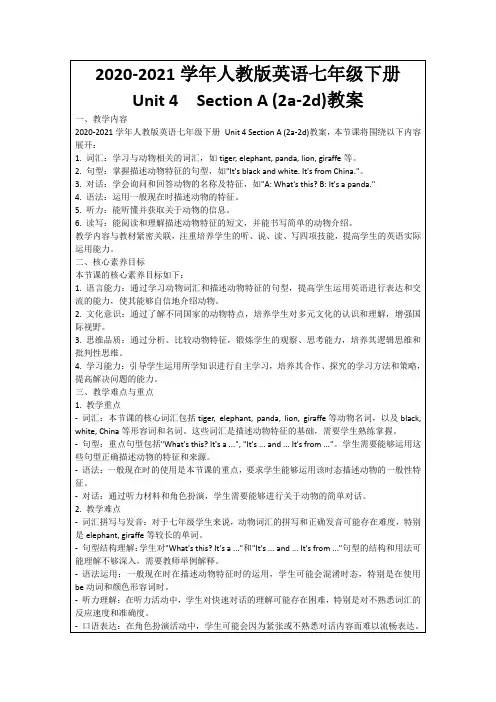
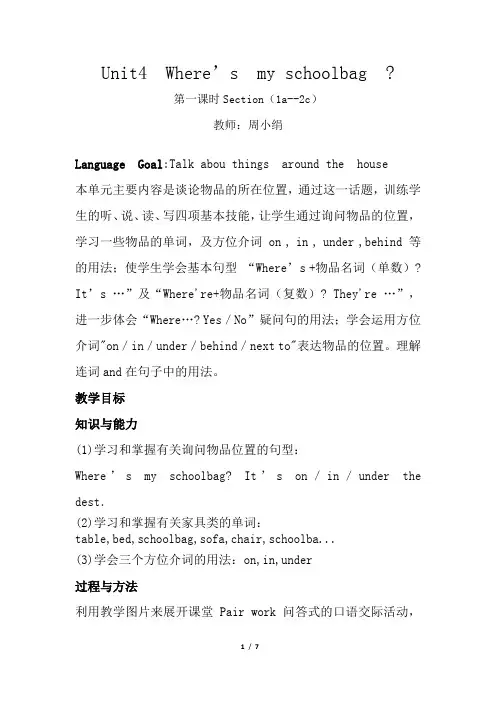
Unit4 Where’s my schoolbag ?第一课时Section(1a--2c)教师:周小绢Language Goal:Talk abou things around the house本单元主要内容是谈论物品的所在位置,通过这一话题,训练学生的听、说、读、写四项基本技能,让学生通过询问物品的位置,学习一些物品的单词,及方位介词 on , in , under ,behind 等的用法;使学生学会基本句型“Where’s +物品名词(单数)? It’s …”及“Where're+物品名词(复数)? They're …”,进一步体会“Where…? Yes/No”疑问句的用法;学会运用方位介词"on/in/under/behind/next to"表达物品的位置。
理解连词and在句子中的用法。
教学目标知识与能力(1)学习和掌握有关询问物品位置的句型:Where’s my schoolbag? It’s on/in/under the dest.(2)学习和掌握有关家具类的单词:table,bed,schoolbag,sofa,chair,schoolba...(3)学会三个方位介词的用法:on,in,under过程与方法利用教学图片来展开课堂Pair work 问答式的口语交际活动,使学生学会基本句型“Where’s my schoolbag ? ”It’s under the chair.及方位介词情感态度价值观这部分学习内容贴近学生的生活,谈论的主题是学生最关心的问题,促使学生了解自己的家居环境,热爱自己的家。
教学重点(1)方位介词:in, on,under的用法;(2).Where的特殊疑问句(3)新单词:chair,bed,table,bookcase,radio,sofa,head... 教学难点1)能够准确运用方位介词描述物品所在的位置;2)能够运用Where问句找到物品的位置。
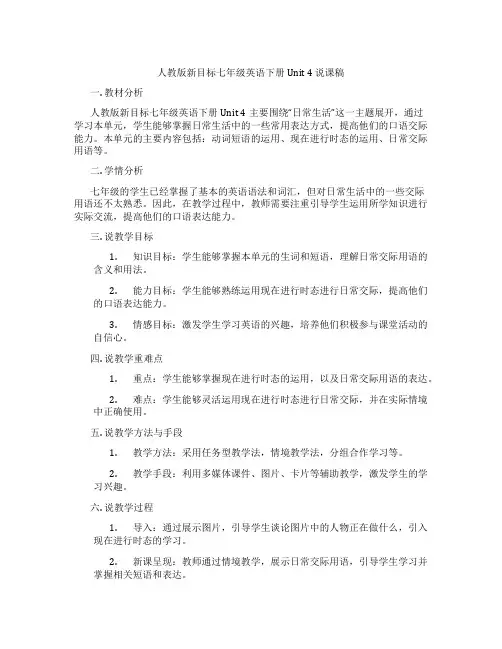
人教版新目标七年级英语下册 Unit 4 说课稿一. 教材分析人教版新目标七年级英语下册Unit 4主要围绕“日常生活”这一主题展开,通过学习本单元,学生能够掌握日常生活中的一些常用表达方式,提高他们的口语交际能力。
本单元的主要内容包括:动词短语的运用、现在进行时态的运用、日常交际用语等。
二. 学情分析七年级的学生已经掌握了基本的英语语法和词汇,但对日常生活中的一些交际用语还不太熟悉。
因此,在教学过程中,教师需要注重引导学生运用所学知识进行实际交流,提高他们的口语表达能力。
三. 说教学目标1.知识目标:学生能够掌握本单元的生词和短语,理解日常交际用语的含义和用法。
2.能力目标:学生能够熟练运用现在进行时态进行日常交际,提高他们的口语表达能力。
3.情感目标:激发学生学习英语的兴趣,培养他们积极参与课堂活动的自信心。
四. 说教学重难点1.重点:学生能够掌握现在进行时态的运用,以及日常交际用语的表达。
2.难点:学生能够灵活运用现在进行时态进行日常交际,并在实际情境中正确使用。
五. 说教学方法与手段1.教学方法:采用任务型教学法,情境教学法,分组合作学习等。
2.教学手段:利用多媒体课件、图片、卡片等辅助教学,激发学生的学习兴趣。
六. 说教学过程1.导入:通过展示图片,引导学生谈论图片中的人物正在做什么,引入现在进行时态的学习。
2.新课呈现:教师通过情境教学,展示日常交际用语,引导学生学习并掌握相关短语和表达。
3.课堂练习:学生分组进行角色扮演,运用所学知识进行实际交流,教师给予指导和反馈。
4.巩固环节:学生进行听力练习,观看相关情景对话,理解并运用日常交际用语。
5.拓展环节:学生进行小组讨论,创造性地运用所学知识,创作自己的日常交际对话。
6.总结:教师对本节课的主要内容进行总结,强调现在进行时态的运用和日常交际用语的重要性。
七. 说板书设计板书设计要简洁明了,突出重点。
主要包括现在进行时态的构成、日常交际用语的表达等。
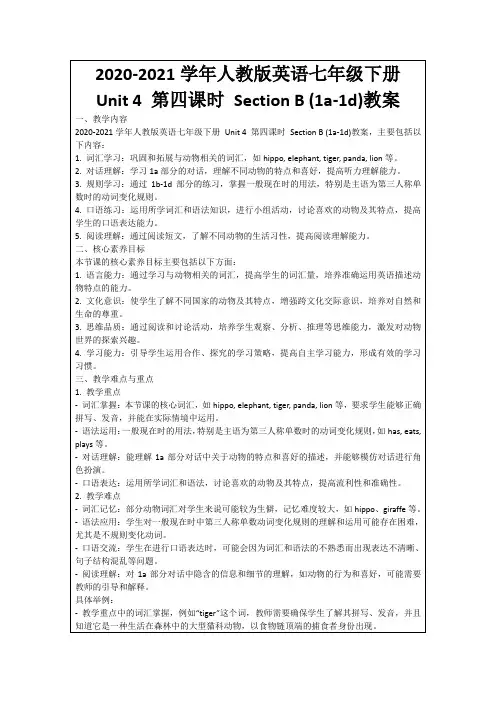
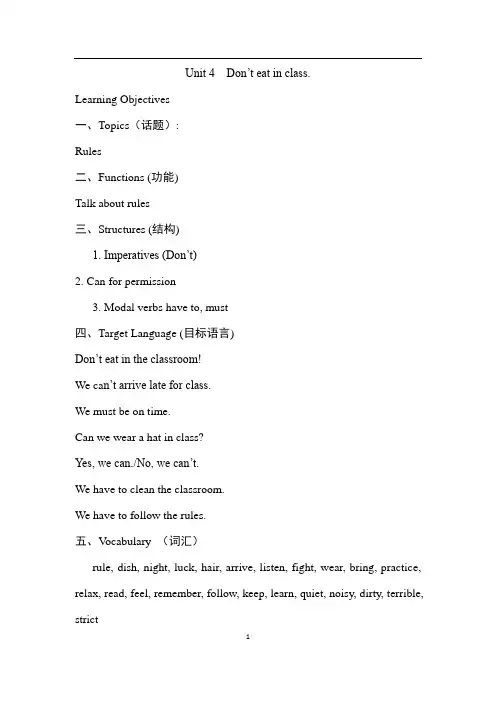
Unit 4 Don’t eat in class.Learning Objectives一、Topics(话题):Rules二、Functions (功能)Talk about rules三、Structures (结构)1. Imperatives (Don’t)2. Can for permission3. Modal verbs have to, must四、Target Language (目标语言)Don’t eat in the classroom!We ca n’t arrive late for class.We must be on time.Can we wear a hat in class?Yes, we can./No, we can’t.We have to clean the classroom.We have to follow the rules.五、V ocabulary (词汇)rule, dish, night, luck, hair, arrive, listen, fight, wear, bring, practice, relax, read, feel, remember, follow, keep, learn, quiet, noisy, dirty, terrible, strictarrive late for class, be on time, listen to music, do the dishes, make your bed, be strict with …, follow the rules六、Skills (技能)Listening for key informationScanning in reading七、Recycling (复习巩固)go out, do your homework, watch TV, clean your room, help your mom make breakfast, in the evening, every Saturday八、教材分析这本教材的词汇量很大,有难度,但是,内容新颖,尤其是生动活泼的卡通化的画面,很符合七年级学生的年龄特点和心理特点,其中还囊括了丰富多彩的文化知识,以及合作探究的活动,十分贴近学生的实际生活经验。

课题名称:Unit 4 How do you make a banana milk shake?Section A 1a-1c一、教学设计指导思想和理论依据《英语新课程标准》注重培养学生学习英语的兴趣,树立自信心,培养学生良好的学习习惯,运用有效的学习策略培养学生自主学习能力和小组合作精神。
遵循学生的认知规律,从单词——句子——情景对话入手,围绕目标语言,由浅入深、由易到难的完成教师设计的任务,使学生在完成任务的过程中不仅从听说等方面掌握目标语言,而且在这过程中不断思考、有所创新。
利用多媒体和网络技术为学生创设真实可视的英语学习环境,激发学生积极参与的欲望,体现了学生的主体地位。
努力实现《英语新课程标准》语言教育理念是:知识用于行动,强调语言应用,培养创新实践能力,发展学习策略。
二、教学背景的分析1.教学内容分析本课是新目标英语七年级下册第四单元第一课时,教材以How do you make a banana milk shake?为中心话题。
本单元是一个有兴趣,愉悦的话题,无疑还会提高学生运用英语的兴趣和交际能力。
本节课是围绕“如何制作香蕉奶昔”为话题展开的,我们在前面已经学习了一些祈使句的用法,因此本单元是对祈使句的深化和延深,通过讲述制做过程和步骤,如何听懂指令、通过听与说的训练,学会准确地判断指令,有序地处理事情,学习运用顺序词,通过动手实际操作,培养和锻炼学生生活能力。
2.学情分析本课的教学对象为七年级46名学生,女生所占比重较大,女生英语学习水平总体较男生好,但男生课堂活动参与度较高,有一部分学生在英语学习上还有很大困难,因此在课堂上有部分学生不敢举手或者很少回答老师的问题,因此在课堂活动中分配小组成员时注重男女比例和分层教学。
七年级学生对英语感到有趣好奇,上课时我多以简单的口语知识作为切入点,让学生更易接受,从熟悉的内容转到新内容的学习,做到过渡自然。
对于学过的内容也可能没有完全掌握,则可以花时间较完整地复习学过内容,然后才学习新知识。
Unit4 SectionA(Grammar Focus3c)参考教案一、教学目标:1. 语言知识目标:词汇学习:掌握新词汇sugar, cheese, popcorn, corn, machine, dig, hole,并复习Section A中的相关词汇。
语法运用:进一步巩固和应用如何用how much和how many来询问事物的数量。
过程描述:能够流畅地使用英语描述制作爆米花的简单过程,并正确使用表示顺序的词汇。
2. 情感态度价值观目标:生活技能培养:通过学习制作爆米花,增强学生的实践操作能力,并了解相关的生活知识。
珍惜劳动成果:让学生认识到制作食物的艰辛,从而懂得珍惜食物,不浪费。
二、教学重难点1. 教学重点:词汇与词组的运用:确保学生能够熟练运用Section A中的词汇和本课的新词汇。
数量提问的掌握:学生能够自如地使用how much和how many来询问食物的数量。
2. 教学难点:过程描述的准确性:能够清晰、准确地描述爆米花的制作过程,包括各个步骤和所需的材料。
名词的可数与不可数:学生能够正确区分可数名词与不可数名词,并会用适当的数量词来描述不可数名三、教学过程Ⅰ. Warming up and revisionGame: How do you make a banana milk shake?Teacher: Let's play a game. We're going to learn how to make a banana milk shake. Who wants to describe the steps first?Student 1: First, you peel the banana.Teacher: Great! Next?Student 2: Next, you put the banana into the blender.Teacher: And then?Student 3: Then, you pour the milk into the blender.Teacher: Finally?Student 4: Finally, you turn on the blender and mix it well.Teacher: Very good! Remember to use "first, next, then, finally" correctly when describing processes.How do you make a Russian soup?Teacher: Now, let's try with a different recipe. How do you make a Russian soup? Student 5: First, you heat the water.Teacher: And?Student 6: Next, you add the vegetables and meat.Teacher: Continue...Student 7: Then, you let it boil for a while.Teacher: And finally?Student 8: Finally, you add salt and pepper to taste, and serve it hot.Teacher: Excellent! Remember, using "first, next, then, finally" helps make instructions clear and easy to follow.Ⅱ. Grammar Focus.1. 学生阅读Grammar Focus中的句子,然后做填空练习。
UNIT 4Don ’teat in class.Section A第1课时(1a~1c)自主学习方案1.自学生词,并记着拼读及拼写。
2.预习课本找出要点短语及句子。
(见教案自学导练内容)3.读记后达成自学导练内容。
讲堂导学方案Step 1 情形导入Show the students the picture of fighting.T:Look at the two boys. What are they doing?Ss:(Help Ss) :They are fighting.T : Can we fight?Ss:No,we can't.T : What should we say to the boys?Ss:We should say to them: Don't fight.环节说明:经过师生对话引出新知识—祈使句。
Step 2 达成教材 1a_1c 的任务1.学习 la 中的学校规定,高声朗诵这些规定,而后将这些规定的序号填在相对应的人物旁边。
(3 分钟)2.认真听录音,找出Peter, Amy 和 Mike 违犯了哪些规定,在lb 中的横线上写出la中的数字,师生共同查对答案。
(2 分钟)3.再听一遍录音,同时跟读。
(2 分钟)4.练习 lc 中的对话。
而后编写新对话,小组内进行对话练习,并进行组与组之间的比赛,教师评论。
(5 分钟)5.小结训练。
(3 分钟)把以下祈使句改成否认形式。
(1)Eat in the hall.(2)Talk loudly.Don't eat in the hall. Don't talk loudly.环节说明:听闻联合,第一时间向学生传达语言目标,经过结对对话练习和小结训练,学生能够娴熟掌握祈使句。
Step3 问题研究1.arrive 的用法用arrive,arrive in/at 填空。
(1)When do you arrive in Shanghai every week?(2)When I arrive at Yucai Middle School in Shanghai,it is 7:50.(3)After I arrive here, I begin my class.【注意】 arrive“抵达”,arrive 是一个不及物动词,不可以直接跟表示地址的名词。
人教版七年级下册英语第四单元单元结构化活动设计教学目标:1、要引导学生走进文本,为文本中的人和事所感动,从中受到启发和教育;2、带领学生走出文本,回到多彩的现实中,联系生活实际,感悟待人3、再回到文本:对于课文中给人深刻启示的重点语句,能够熟读成诵,牢记于心,自觉用这些富有哲理的话来指导和规范自己的行为,做一个诚实善良、乐观向上、有益于社会的人教学重点联系生活实际,感悟待人。
课前准备1、学生熟读课文,理清课文脉络。
2、教师准备课件、图片。
课题:《钓鱼的启示》与《通往广场的路不止一条》《落花生》与《珍珠鸟》第一课时教学目标:1、能正确认读38个生字,会写24个生字。
能正确读写“捕捞、鱼饵、鱼钩、小心翼翼、操纵、皎洁、沮丧、诱惑、告诫、实践”等词语2.有感情地朗读课文,了解单元主题。
3、理解基本词语的意思及了解本单元的近反义词。
教学过程:一、解决本单元生字词(一)、词语解释涟漪:细小的波纹。
小心翼翼:非常小心,丝毫不敢疏忽。
翕动:翕,收敛。
(嘴唇)一张一合。
皎洁:(月亮)明亮而洁白。
乞求:请求(对方)答应。
不容争辩:不允许争论、辩解。
诱惑:吸引。
抉择:挑选,选择。
告诫:警告,劝诫(多用于上级对下级或长辈对晚辈)。
星罗棋布:像天上的群星和棋盘上的棋子那样罗列分布。
形容数量众多,散布的范围很广。
环抱:围绕,多用于自然景物,如“群山环抱”。
大喜过望:望,希望。
所得超过了原来的期望,因而特别高兴。
心灵手巧:心思灵敏,手艺精巧。
挑拨:搬弄是非,引起纠纷。
络绎不绝:络绎,往来不断,前后相继。
形容过往的人或车辆连接不断。
开辟:开拓发展。
居然:表示出乎意料;竟然。
吩咐:口头指派或命令。
爱慕:由于喜爱或敬重而愿意接近。
分辨:辨别。
体面:(相貌、样子或穿着)好看;有气派。
深幽:深而幽静。
斑斑驳驳:指一种颜色中夹杂有别种颜色,花花搭搭的;也指阳光透过物体的缝隙照射下来,形成许多不规则的光点,明明暗暗的。
本文指吊兰的叶子在阳光下明明暗暗,颜色不一,相互交错。
Unit4. Don’t eat in class 教案学案Section A 1a—2d(听说课)【学习目标】一、知识目标:1. 掌握本课单词: rule, arrive, hallway, hall, listen, fight, sorry, outside, wear, important, bring,uniform, quiet.2. 重点短语:dining hall, arrive late for school, (be) on time, listen to music, go out, follow/breakthe rules, in class, be/ keep quiet, a lot of, bring …to…,wear a hat, have to, musicplayers3. 重点句型:能正确使用否定祈使句陈述规章要求,对别人的劝告,警告作出礼貌回应——Don’t run in the hallways. / Don’t fight.——Sorry, Ms Clark;正确使用情态动词can, can’t——Can we wear a hat in school?——Yes, we can./No, we can’t.能正确使用have to 和must 谈论规章制度We must be on time/ We also have to be quiet in the library.二. 能力目标:听清“can, can’t”;正确使用情态动词和祈使句谈论规章制度。
三. 情感目标:了解校规,规范在校行为。
【重点、难点】1. 重点单词,短语。
2. 重点句型及听力口语训练。
【自主探究】一.请默写下列单词。
P1231.规则 ________2.到达 ________3.走廊________4.大厅________5.餐厅 ________6.倾听________7.打架 ________8.抱歉的 ________二.请默写下列短语。
Unit4Where’smy schoolbag第一课时Section(1a--2c)教师:周小绢LanguageGoal:Talk abou thingsaround thehouse本单元主要内容是谈论物品的所在位置,通过这一话题,训练学生的听、说、读、写四项基本技能,让学生通过询问物品的位置,学习一些物品的单词,及方位介词on , in , under ,behind 等的用法;使学生学会基本句型“Where’s +物品名词(单数)It’s …”及“Where're+物品名词(复数)They're …”,进一步体会“Where… Yes/No”疑问句的用法;学会运用方位介词"on/in/under/behind/next to"表达物品的位置。
理解连词and在句子中的用法。
教学目标知识与能力(1)学习和掌握有关询问物品位置的句型:Where’smyschoolbagIt’son/in/underthe dest.(2)学习和掌握有关家具类的单词:table,bed,schoolbag,sofa,chair,schoolba...(3)学会三个方位介词的用法:on,in,under过程与方法利用教学图片来展开课堂Pair work 问答式的口语交际活动,使学生学会基本句型“Where’smyschoolbag”It’s under the chair.及方位介词情感态度价值观这部分学习内容贴近学生的生活,谈论的主题是学生最关心的问题,促使学生了解自己的家居环境,热爱自己的家。
教学重点(1)方位介词:in, on,under的用法;(2).Where的特殊疑问句(3)新单词:chair,bed,table,bookcase,radio,sofa,head...教学难点1)能够准确运用方位介词描述物品所在的位置;2)能够运用Where问句找到物品的位置。
教学方法Practicing,listeningandspeaking教学准备收集本课中所涉及的或学生常见的学习、生活用品、家具或有关的图片,将听力部分的内容插入,通过询问“物品的位置”,以及回答来引入新课。
教学步骤:Step One :Warming up and revision1.(Prepare some school things.)T: What’s this(There is a watch in the teacher’s hand.)S1: It's a watch.Yes,you are right. Here you are.T: Is this a notebook(holding up a notebook .)S2: Yes, it is.T: How do you spell notebookS2: N-O-T-B-O-O-K, notebook.T: Good.(Hold up a pen, an erase, some pencils and so on. Ask the questions in the same way.)T: What’s thisS3: It’s a schoolbag.T: I have a schoolbag for you as a present, (Looking for it in the desk, under the chair . . . )but I can’t find it . Where’s it Do you knowS3: I don’t know.S4: I think it’s in your desk.T: (Look into the desk.) No, it isn’t. Now, let’s look for the backpack together, OK(Write down the title on the blackboard.)2. Work on 1a.Now let's look at the picture in 1a. Match the words with the things in the picture.Check the answers with the class.Step Two: Learn the new words1.Show the new words to students (1a)Now, Let’s practice them .Open your English book turn to P19 pay more attention to the the words with the things in the pictures.2.Pretend to look for your backpack here and thereT: I can’t find my back backpack Where is itS1:I think it’s on the desk.T: Where are your backpackS1:They are in the desk.T: Where is my penS2: It’s under the desk.Step Three: Listening1. Let Ss listen to the tape and finish 1b.2. Ss listen to the tape and number the things [1-4]in the picture.3. Check the answers with the class.Step Four: Pair work (1c)Make your own conversations. Use the words in the box. Try to use the direction preposition. Pay more attention to the direction preposition in your conversation.Eg: S: Where are your backpackS1: hey are in the desk.S: Where is my penS2: It’s under the desk.S: Where is my rulerS3: It is on your bed.Step Five: Role-play1. Jack is a forgetful boy. He always doesn't know where his things are. Let's help him find his things.Match the things with the right places below.(Let Ss look at the screen. There are some things and some places)bag on her headmap on the sofahat on the bed in his grandparents' room2. Ss read the conversation and match the things with the right places.3. Check the answers.4. Now practice the conversation with your partner. Then let some pairs act out the conversation.Step Six: SummaryIt’s a new lesson of this lesson, We mainly learned how to talk about where things are and we can according to the yes/no question give the short and right answer.Step Seven :Homework参照教室里的东西用介词in,on,under写3个句子。
教学反思:教材中有许多听力练习、句型教学、词汇教学,对于七年级刚接触听力不久的学生需要运用听关键词的技巧(所谓关键词即听力材料中最关键的信息)。
本课时中通过操练句型“Where’s my schoolbag”“It’s in/on/under…”,帮助对关键词“in/on…”,及“Where’s…”句型的理解。
这种技巧的运用有利于培养学生的注意力。
教师通过对不同事物位置在那个置的提问,将学生的注意力集中在不同的方位上,老师在提问之后,自己回答并有意识的加重方位词“in,on,under,behind,nest to”的读音。
同是要求学生重复自己的回答。
听关键词不仅仅利于培养学生对听力的把握,还能激发学生对听力的兴趣,有利于学生在今后听力学习中找到学习听力的技巧和方法。
板书设计Unit4Where’smyschoolbagSection(1a----2c)Word:table bed bookcase sofa chair desk hat radio tape clock tape player …Drills:Where is/are …1)It is in/on/under/behind/next to…2)They are in/on/under/behind/next to…Grammar:Where is/are…In/on/under/behind/next to…。